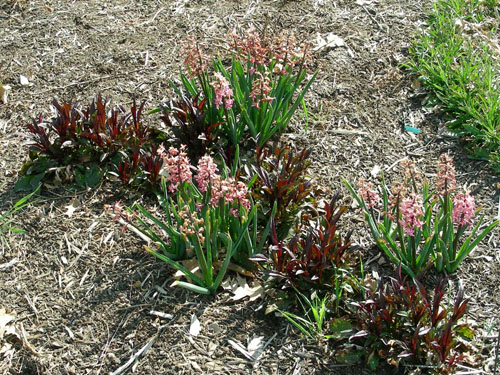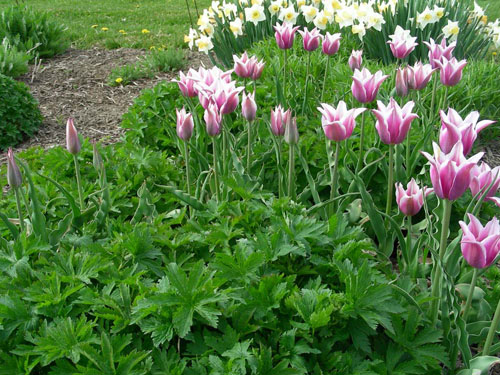 |
Bulbs and perennials can be a lot like brothers and
sisters.
You love them both but they don’t always play well together.
Spring bulbs always insist on going to the head of the line and can stifle the younger, impressionable plants. Perennials, on the other hand, are quick to throw a tantrum when they are stuck with the ugly, dying foliage that bulbs leave behind. What’s
a gardener to do?
 There's lots of information out there about
combining either bulbs or perennials. Mixing the two together, however, not
so much.
There's lots of information out there about
combining either bulbs or perennials. Mixing the two together, however, not
so much.
I’m especially interested in the topic because I need to
revamp several of my garden beds this fall. That's partly due to the drought, but also
because my tulips are close to the end of their useful lives.
With bulbs due in the stores any day now and catalogs already in my mailbox, I decided it was time to re-examine the way I use them with perennials.
In the past, I've had mixed results combining daffodils and daylilies. I've also occasionally planted bulbs near hostas and ferns. Both of these latter two plants, though, require shade which is a rare commodity in my young garden.
There must be
a better way.
Much of the information I found was extremely general, suggesting that you plant bulbs behind perennials that will emerge later. That unfortunately doesn't always work. Often, the perennial partner is either too fast or too slow, too early or too late. The combination pictured at the top -- pink tulips with Early Bird catmint (Nepeta 'Early Bird') in front and Little Grapette' daylily (Hemerocallis 'Little Grapette') at right -- is one that doesn't quite work in my garden for those reasons. The National Gardening Association has a few suggestions. You're out of luck though if your bulb aspirations go beyond flowering onions (Allium), spider lily (Lycoris) or purple and lavender tulips.
The National Gardening Association has a few suggestions. You're out of luck though if your bulb aspirations go beyond flowering onions (Allium), spider lily (Lycoris) or purple and lavender tulips.
The late, great British plantsman Christopher Lloyd, in his book Succession
Planting for Year-Round Pleasure, had many suggestions in a chapter devoted to perennials and bulbs
that share the same space.
"You need to consider the habit and vigour of both the protagonist and its partner(s)," he wrote."What you must never use in any part of a mixed border are broad-leaved daffodils, but I constantly see this mistake being made. They are far too aggressive...."
One of his combinations that lasts for several months: Narcissus ‘Dove Wings,’ a Triandrus type of daffodil, plus Hemerocallis ‘Marion Vaughn’ and Phlox paniculata.
Alas, many of the plants he mentioned won't grow in my Zone 5 garden. He did, however, pair bulbs with plants that bloom later in the season. I especially think that his suggestion of Allium cristophii and Japanese anemones would work well.
One of his combinations that lasts for several months: Narcissus ‘Dove Wings,’ a Triandrus type of daffodil, plus Hemerocallis ‘Marion Vaughn’ and Phlox paniculata.
Alas, many of the plants he mentioned won't grow in my Zone 5 garden. He did, however, pair bulbs with plants that bloom later in the season. I especially think that his suggestion of Allium cristophii and Japanese anemones would work well.
Online, there are some other interesting combinations on an industry-sponsored Website, www.digdropdone.com. (Just ignore the female stereotypes, which garnered a lot of criticism when the site went live last spring.)
About a third of its suggested pairings, though, can also be found on a more extensive site, www.hort.cornell.edu/combos. That site includes a number of mixtures tested by the Cornell University's Department of Horticulture. It includes pictures of each combination in various stages of growth.
 |
| Hyacinth 'Jan Bos' with Penstemon 'Husker Red' Photo used with permission of Cornell University Department of Horticulture |
Suggested pairings cover tulips, narcissus, crocus and miscellaneous bulbs. I especially like the combination of Hyacinth ‘Jan Bos’ with Penstemon ‘Husker Red.” The red foliage of the Penstemon complements the flowers nicely.
 |
| Tulip Ballade with Geranium 'Mayflower' Photo used with permission of Cornell University Department of Horticulture |
In any event, I still have plenty of time to do some planning. The drought is still hanging on and the ground temperature has a long way to go until it falls to the 55-degree mark preferred for bulb planting.
My goal is a simple one: peace in the garden next spring, with everything working together like one big, happy -- and beautiful -- family.
By Karen Geisler
My goal is a simple one: peace in the garden next spring, with everything working together like one big, happy -- and beautiful -- family.
By Karen Geisler

16 comments:
Interesting subject! I have daffodils planted with hostas, and the short time that they flower (and the fact that the flowers are so heavy they fall over)hardly seems worth having to put up with the foliage when the hostas are coming out. I always threaten to dig them up, but never have...thanks for reminding me, and for offering solutions and resources to address the problem! Good post!!
I have two thoughts on this. First, consider species tulips. They have bloom earlier than hybrid tulips, have wonderful color and smaller foliage. Then, combine with perennials that emerge late, such as milkweeds, ratibida, or warm season grasses.
Very thought-provoking, Karen. I can't take much credit for the bulb/perennial pairings in my garden as most were planted by the previous owners. But the Hostas do a nice job of covering messy bulb foliage. Hostas and Lycoris are a good combination because of their timing and their complimentary forms and growth patterns. Great post!
I especially like the combination of Peony and the large Allium, one I have used to great effect in my own garden. The peony covers the Allium foliage very nicely and the blooms of both look great together.
Thanks. I'm hoping that the suggestion about narrow-leaved daffodils works for me!
Hmmm... thanks for the suggestions. I haven't had much luck with milkweed in my garden, unfortunately. Have already been thinking about adding ratibida. Will definitely have to try it.
Lycoris is definitely on my shopping list for this fall. Can't wait until I get more shade so I can give my lone hosta some company.
I do have several peonies. Hadn't thought about adding allium to the mix. Unfortunately my peonies haven't been doing so well this year with the drought. Thanks for the tip!
I find the John Scheeper's catalog and website are great for bulb mixing. I have used many of the combos and they pretty reliably bloom as they pictured. Another thing I do is broadcast bulbs. I find the squirrels and expansion and contraction do it anyway, so nature makes some beautifully surprising vignettes.
Good suggestion. I've never naturalized bulbs, but am thinking I may try it with some smaller bulbs this fall.
I too keep working on it so I am anxious to hear what you find...i also Like Scheepers and I love to plant those bulbs that naturalize. I tend to stay away from any more tulips as the deer love them and they just don't come back in my zone 5...
Wow! That is indeed a very cool page. I am doing some companion planting myself. I must say that those tulips are just lovely! Thanks!
I have ordered my bulbs but as usual I don't remember all that I ordered, so it will be a surprise when they come. I am trying to plant some bulbs on the north side, but I will need some that grow in the shade, not dense but much cooler over there.
Brunnera Jack Frost is also a lovely coverup for bulb foliage.
Eileen
My tulips only come back for a few years as well. I've tended to plant more daffodils as a result.
Thanks for the suggestion about the brunnera. As far as bulbs, have you tried snowdrops or galanthus? They're the only bulb I know of that will take some shade and some wet. I'm planning to try some of these next spring.
You're welcome. Thanks for stopping by!
Post a Comment